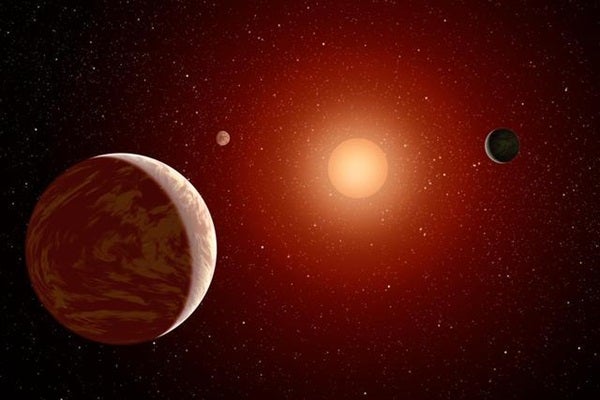The hunt for habitability outside our solar system is both ongoing and won’t be slowing down anytime soon. The pursuit of exoplanets not only furthers the search for extraterrestrial life, but also helps us understand the formation and evolution of celestial objects, including those close to home. With the help of space- and ground-based telescopes, a group of researchers surveying red dwarf stars near Earth identified 15 new exoplanets — and one of them has the potential to host liquid water.
The team of researchers, led by Teruyuki Hirano of Tokyo Institute of Technology’s Department of Earth and Planetary Sciences, used data from NASA’s Kepler spacecraft and observations from Spain’s Nordic Optical Telescope and Hawaii’s Subaru Telescope to carry out the study. The findings were published in The Astronomical Journal in a series of two papers.
The “star” of the study is K2-155, a bright red dwarf about 200 light-years away. The researchers found three super-Earths (planets larger than Earth but smaller than Neptune) orbiting the star, with the farthest planet, K2-155d, potentially in its habitable zone. By measuring the radius of K2-155d, which is estimated at about 1.6 times that of Earth, and using a 3-D global climate simulation, they found it’s highly probable that liquid water could exist on its surface.
The team can’t say this with certainty, though, because the unmeasured radius and temperature of its host star could impact K2-155d’s habitability — habitability that also depends on the assumptions that go into the simulation. “In our simulations, the atmosphere and the composition of the planet were assumed to be Earth-like, and there’s no guarantee that this is the case,” said Hirano in a press release.
It addition to studying K2-155d, the team evaluated the similarities and differences between planets that orbit solar-type stars, like the Sun, and planets that orbit red dwarfs. They found that both types of systems have similar radius gaps among their planets, meaning that neither is likely to harbor planets with radii between 1.5 to 2 times that of Earth. The researchers believe this gap may be due to photoevaporation, which rids planets of their outer atmospheric envelope if they get too close to their host star, shedding mass in the process.
The researchers also looked for correlations between a host star’s metallicity (the amount elements heavier than helium they contain) and the radii of planets around it. They found an absence of large planets around host stars with low metallicity, as expected. “Large planets are only discovered around metal-rich stars,” Hirano said. “And what we found was consistent with our predictions. The few planets with a radius about three times that of Earth were found orbiting the most metal-rich red dwarfs.”
Looking forward, Hirano hopes to use NASA’s Transiting Exoplanet Survey Satellite (TESS), set to launch in April, to conduct follow-up investigations and observe planetary orbits and atmospheres in greater detail.
“Red dwarf systems, especially coolest red dwarfs, are just beginning to be investigated, so they are very exciting targets for future exoplanet research,” said Hirano.










